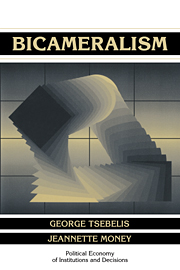Book contents
- Frontmatter
- Contents
- List of tables and figures
- Series editors' preface
- Acknowledgments
- Introduction
- PART I THE HISTORY AND GEOGRAPHY OF BICAMERAL DIVERSITY
- Introduction to Part I
- 1 Bicameralism in historical perspective
- 2 The institutions of bicameralism
- PART II MODELS OF BICAMERAL INSTITUTIONS
- PART III EMPIRICAL STUDIES OF BICAMERALISM AND IMPLICATIONS
- Conclusions
- References
- Index
Introduction to Part I
Published online by Cambridge University Press: 02 December 2009
- Frontmatter
- Contents
- List of tables and figures
- Series editors' preface
- Acknowledgments
- Introduction
- PART I THE HISTORY AND GEOGRAPHY OF BICAMERAL DIVERSITY
- Introduction to Part I
- 1 Bicameralism in historical perspective
- 2 The institutions of bicameralism
- PART II MODELS OF BICAMERAL INSTITUTIONS
- PART III EMPIRICAL STUDIES OF BICAMERALISM AND IMPLICATIONS
- Conclusions
- References
- Index
Summary
The goal of Part I is to present the diversity of bicameral institutions over time and among countries, as well as the diversity of theoretical justifications employed to promote them. Bicameral institutions have been adopted by class societies and by federal states, by republican polities and by unitary political systems. They have been used to maintain the status quo, to amalgamate the preferences of different constituencies, and to improve legislation, and have been justified in all of these terms. The diversity of bicameral legislatures extends to the institutional devices employed to resolve differences between the two legislative chambers, the navette (shuttle) system, conference committees, joint sessions of two chambers, one-chamber decisions; these are rules that may be applied individually or in combination. In a word, bicameral institutions are protean. They change forms and functions, and the arguments that justify or explain them follow these transformations.
This part of the book is divided into two chapters. Chapter 1 focuses on the history of bicameral diversity and presents the different theoretical justifications for bicameralism, while Chapter 2 provides information about the geographic dimension, the institutions regulating bicameral interactions in different countries today.
Chapter 1 begins with the earliest known political institutions that divided legislative deliberations between two or more chambers and follows the institutional evolution up to the modern period. At the same time, we trace the intellectual debate about the merits of this institutional structure. We describe the reasons proffered by various politicians and political theorists to justify the existence of two legislative bodies. The historical presentation emphasizes the dual evolution of institutional structures and intellectual debates.
- Type
- Chapter
- Information
- Bicameralism , pp. 13 - 14Publisher: Cambridge University PressPrint publication year: 1997



